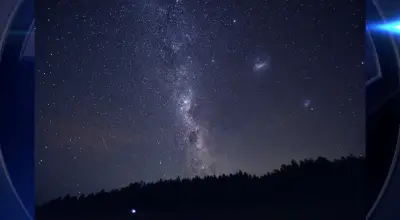Scientists think the mysterious glow in our galaxy could be from dark matter. What that means

CNN At the center of our galaxy there s a mysterious diffuse glow given off by gamma rays powerful radiation usually emitted by high-energy objects such as rapidly rotating or exploding stars NASA s Fermi Gamma-ray Space Telescope detected the glow shortly after launching in and the light has puzzled scientists ever since prompting speculation on its cause Chosen astronomers believe the source of the glow to be pulsars the spinning leftovers of exploded stars while others point to colliding particles of dark matter an elusive and invisible form of matter that is considered to be five times more abundant than regular matter Numerous studies have previously exposed endorsement for both ideas but there seemed to be a predicament with the dark matter theory The gamma ray glow appeared to match the shape of the galactic bulge a crowded bulbous region at the center of the Milky Way that s mostly made up of old stars including pulsars This observation seemed to promotion the pulsar theory with experts theorizing that the glow would have taken a more spherical form if its source were dark matter However astronomers haven t been able to observe enough of the pulsars that would be producing the gamma rays to make a conclusive assessment Now new simulations made using supercomputers show for the first time that dark matter collisions could also have created the bulge-shaped glow adding weight to the dark matter theory We re in the situation where we have two theories one posturing dark matter and claiming that it could explain the figures we see another one old stars commented Joseph Silk a professor of physics and astronomy at the Johns Hopkins University and coauthor of a assessment detailing the new findings published Thursday in the journal Physical Review Letters There s a chance that it might be dark matter at this point as opposed to the slightly more mundane explanation of old stars in my opinion Evidence of dark matter would make for a groundbreaking discovery Swiss astronomer Fritz Zwicky first theorized dark matter s existence in the s and American astronomers Vera Rubin and W Kent Ford ratified it in the s They noticed that stars orbiting at the edge of spiral galaxies were moving too expeditiously to be held together by visible matter and gravity alone and postulated that there was a large unseen quantity of matter preventing them from flying apart Despite decades of effort scientists have never observed the mysterious substance directly hence its name There s no question that the nature of dark matter is one of the outstanding major problems in physics Silk reported It s something that s everywhere near us far from us and we just don t know what it is Hunting for WIMPs There are multiple hypotheses on what dark matter could be including remnants of primordial black holes or an undiscovered type of particle Much of the effort to find dark matter has centered on the latter idea leading to the construction of detectors such as the LZ Dark Matter Experiment in South Dakota The instrument is designed to spot one of the leading dark matter candidates hypothetical particles called WIMPs Weakly Interacting Massive Particles which don t absorb light and can pass through regular matter almost seamlessly Scientists believe that when two WIMPs meet they annihilate each other and produce gamma rays which would make them a plausible source of the glow Silk s research used supercomputers to create a map of where dark matter should be in the Milky Way taking into account how the galaxy originally formed The concern was that all of the models over the past years of the dark matter in our galaxy assume it s basically like a spherical ball There is no shape to it because that was the simplest model Silk disclosed Our contribution was for the first time to make a real computer simulation of the dark matter distribution And lo and behold we revealed the central part of the dark matter where the gamma rays would be being emitted to be in fact squashed more like egg-shaped This squashed shape is a close match to the Fermi telescope material Silk explained Luckily confirmation of the link between dark matter and the glow may not be too far in the offing A new instrument the Cherenkov Telescope Array Observatory or CTAO is under construction at two sites one in Chile and another in Spain and will start to return information as soon as CTAO will detect gamma rays at a much higher resolution than Fermi Silk reported making it feasible to tell if the gamma rays at the center of the Milky Way are the product of dark matter collisions That finding would be a breakthrough in the search for the elusive substance he added as well as offer proof that at least a few dark matter is made of WIMPs If on the contrary CTAO doesn t link the glow to dark matter scientists would be back to square one in the search with all options still on the table A fundamental secret The survey helps reopen the possibility that dark matter could explain the glow at our galactic center although it doesn t give new positive evidence in favor of dark matter declared Tracy Slatyer a professor of physics at the Massachusetts Institute of Machinery who was not involved with the review However she is not convinced that there is a definitive match between the shape of the dark matter distribution and the stellar bulge I thought the dark matter hypothesis was still reasonable even before this survey she added This work is further advocacy for the international effort to keep pushing in the hunt for WIMPs according to Chamkaur Ghag a professor of physics and astronomy at University College London who also didn t participate in Silk s research They remain a majority of elegant explanation to the long-standing dark matter obstacle Ghag added via email noting that with even more detectors for WIMPs under growth seeing signals of these particles annihilating in space would mean settling the near-century old puzzle of dark matter Nico Cappelluti an associate professor in the department of physics at the University of Miami explained that the Fermi telescope has been a tournament changer for NASA and this paper shows that dark matter is still very much in the race to explain the strange glow at the center of our galaxy That mystery is alive and it s the kind that keeps scientists like me awake at night mentioned Cappelluti who didn t take part in the research Figuring out what dark matter is has been the scientific quest of our century he added noting that WIMPs these hypothetical particles have been our prime individuals for years The fact that experiments on Earth haven t caught them yet is frustrating he disclosed But Fermi gives us a reason to keep believing This paper reminds us not to cross WIMPs off the list just yet they might still be lighting up the center of our galaxy Cappelluti noted And if that s true we re closer than ever to uncovering a fundamental secret of the universe


